Megan Dwyre
Insight into the Unabomber Case from the Files of its Lead Prosecutor
Today’s post was written by Megan Dwyre, Supervisory Archivist, Special Access and FOIA Program at the National Archives in College Park, MD
This blog post highlights records related to the Unabomber case from the series Electronic Records of Robert J. Cleary, 1999-2002, which was made available through the joint efforts of the Special Access and FOIA Program and the Electronic Records Division at the National Archives in College Park, MD.
Theodore J. Kaczynski, known as “the Unabomber” (the FBI used the case identifier UNABOM, short for University and Airline Bomber), carried out a series of anonymous bombings between 1978 and 1995. After a nearly two-decade investigation, Kaczynski was arrested in April 1996. He pleaded guilty and was sentenced on May 4, 1998 to four consecutive life sentences plus 30 years imprisonment.
This series contains records that document the activities of the Office of the U.S. Attorney for the Judicial District of New Jersey, led by Robert J. Cleary, who served in the position from November 1999 to January 2002. Prior to serving as U.S. Attorney, Cleary was the lead prosecutor in the United States v. Theodore J. Kaczynski. Whereas court records publish an official account of a criminal proceeding, the records in this series offer a glimpse behind the scenes. Cleary’s files highlighted in this blog post date from 1999 to 2002. The files include recollections of his experiences on the UNABOM task force and prosecution team, and document his work related to Kaczynski’s 2001 appeal.
MANHUNT: THE UNABOM TASK FORCE
Between 1999 and 2002, Cleary spoke at several conferences and his lecture notes provide insight into some of his work on the case. His notes for the USAO Anti-Terrorism Conference in Connecticut on January 15, 2002 describe the inner workings of the UNABOM Task Force (UTF) and prosecution team.
The UTF formed in 1979 under FBI guidance, and Cleary explained that the Postal Inspection Service (PIS) had primary jurisdiction for mailed bombs, the Federal Bureau of Investigation (FBI) for the bombs on planes and college campuses, and the Bureau of Alcohol, Tobacco, Firearms and Explosives (ATF) for the placed bombs. Individuals from each agency were assigned to the UTF and worked together “side by side, in a single squad room, reporting to a single supervisor,” which built “a esprit de corps”. Cleary upheld the UTF as “the model of interagency cooperation” that proved “the single most important step in solving these brutal crimes.”
Cleary’s notes also describe how the UTF was organized into two investigative squads, one for “suspects” and one devoted to re-investigation. The suspect squad investigated conflicts with known UNABOM events, and examined official records, trash covers, and writing and typing samples. The reinvestigation squad looked at each incident repeatedly to identify patterns and evidence in light of new facts. Cleary described the work of the UTF as “incredibly labor intensive (the 800 number received 50,000 calls in a 3 month period among other tips from family members, etc.).” While many believed Kaczynski’s brother, David, was responsible for the break in the case, Cleary explained that “the 23-page essay was like so many of the other complaints we heard… just like 1000s of other leads.” In fact, according to Cleary, it was the UTF’s “good, old fashioned investigative police work, coupled with some very sophisticated forensic analysis” that developed the probable cause for the search warrant.
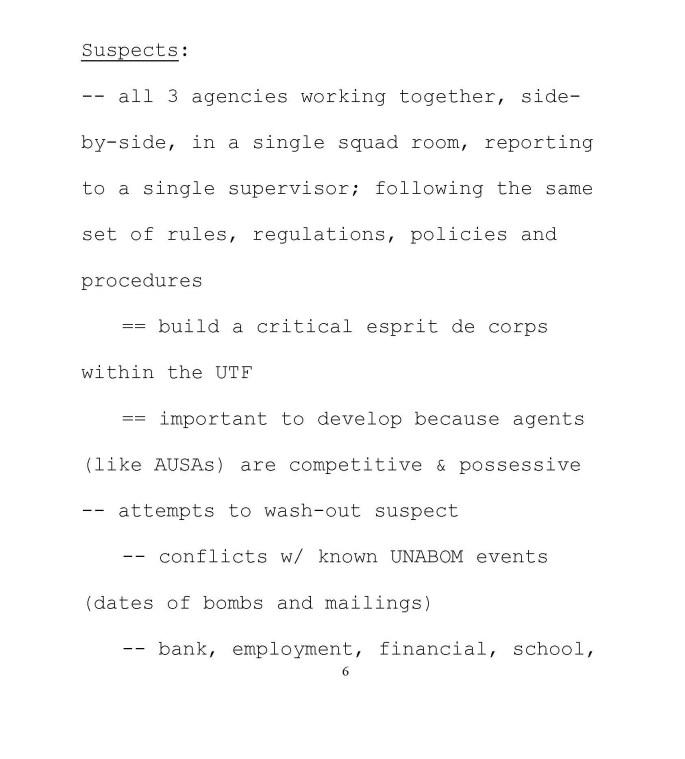
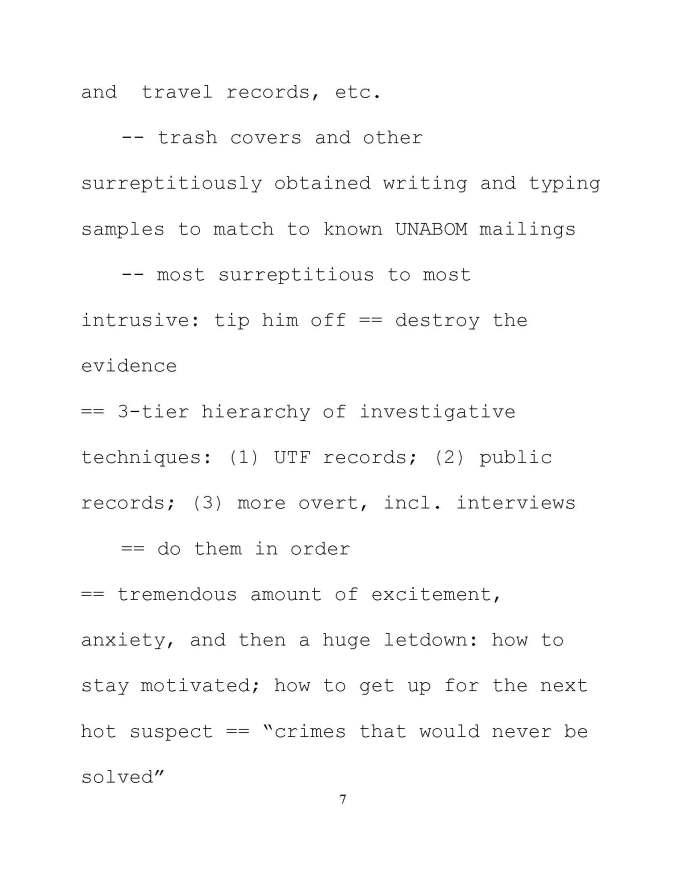
Speech for USAO Anti Terrorism Conference, Jan 12, 2002, page 6-7 (NAID 236736889)
Cleary further described how a six-lawyer prosecution team under his leadership then analyzed evidence and determined where to pursue the indictment and on what charges. He noted a broader mandate to “show what federal law enforcement can do” in a “difficult time (post-OJ; FBI Lab under attack).” He also highlighted the importance of cooperation between the prosecution team and investigators: whereas “in the old days: agents investigate, AUSAs prosecute and ‘ne’er the twain shall meet,” Cleary wrote, “I’ll be blunt: that view is shortsighted, ego-centric and entirely inappropriate.” He described the “new school” of federal law enforcement as “we’re in this together; we’re a team, a partnership; our end result is a package deal: part law, part fact” and his notes go on to detail some specific ways this philosophy was put into practice in the Kaczynski case, as well as valuable lessons learned.
KACZYNSKI’S APPEAL: BEHIND THE BRIEF
In addition to the first-person recollections in Cleary’s lecture notes, this series includes a few documents relating to Kaczynski’s appeal, filed while Cleary was serving as U.S. Attorney for the District of New Jersey. The memos, drafts, and correspondence related to the appeal bring to light the behind-the-scenes work of the prosecutors, their background research, and consideration of various legal arguments.
On April 23, 1999, Kaczynski filed a motion to vacate his conviction, claiming that he was falsely characterized as mentally ill and coerced into a guilty plea. The district court denied the motion and Kaczynski appealed to the U.S. Court of Appeals for the Ninth Circuit.
A December 17, 1999, memorandum to Cleary from the Chief of Appeals, George S. Leone, outlined standards related to the defendant’s attack on the voluntariness of the plea. Four days later, in a memo to the UNABOM Team Cleary wrote, “I’ve been mulling over our possible options in responding to TK [Ted Kaczynski]’s appeal and I think our best course will be to argue that he waived his choice of defense and self-representation claims by entering his guilty plea.” He candidly expressed that Kaczynski had done a “pretty compelling job establishing that his lawyers abandoned him, worked at cross-purposes to his expressed desires, and, in order to bar him from firing them, repeatedly lied to him and prevented him from reading published accounts about the court proceedings”, remarking, “this is pretty unpalatable stuff for us.” The memo goes on to outline possible courses of action and how the government’s argument might proceed, citing legal precedents. Options considered included a procedural default argument that Kaczynski’s claim could only be raised on direct appeal and Kaczynski had already waived his right to file such an appeal, or a merit-based argument that Kaczynski demonstrated he was fully aware of the various courses of action and voluntarily chose to plead guilty. Several subsequent memos follow, which include a list of case citations for the brief, inserts for the brief, and additional legal research related to the appeal.
The series contains several draft versions of the brief for the United States, which show the evolution of the language the team selected. For example, in the section on “Bomb No. 2”, we see different wording in Draft 1, which appears to be J. Douglas Wilson’s draft (annotated “jdw” in file name) and Draft 2 (annotated “rjc” in file name), in which Cleary noted his changes in bold. The final brief ultimately included a combination of the two versions:

Brief U.S. v. Theodore John Kaczynski, appellant; No. 99-16531, in the United States Court of Appeals for the Ninth Circuit; no date, page 9 (NAID 236736913)
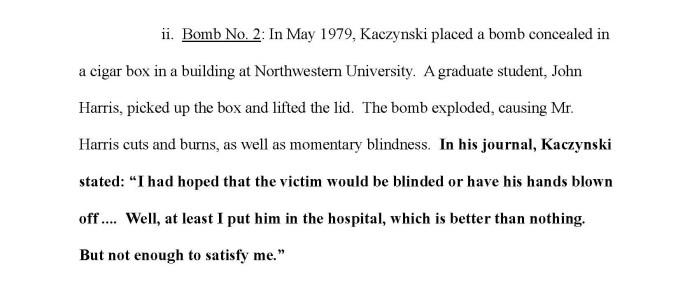
Brief U.S. v. Theodore John Kaczynski, appellant; No. 99-16531, in the United States Court of Appeals for the Ninth Circuit; no date, page 10 (NAID 236736915)
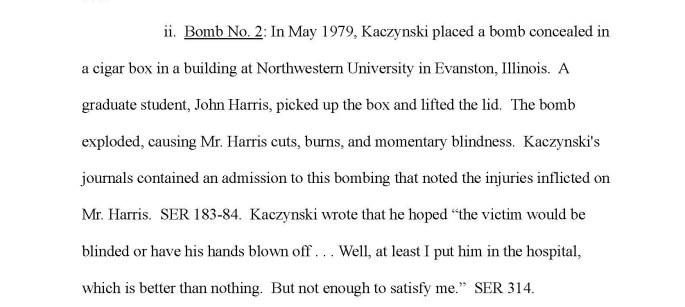
Final Brief U.S. v. Theodore John Kaczynski, appellant; No. 99-16531 in the United States Court of Appeals for the Ninth Circuit; February 11, 2000, page 8 (NAID 236736863)
Near the conclusion of the appeal proceedings, Cleary wrote to fellow Unabomber prosecutor, Merrick Garland, “The end is finally in sight.” Reflecting on the esprit de corps among the prosecution team, Cleary recalled, “Those were good times.”
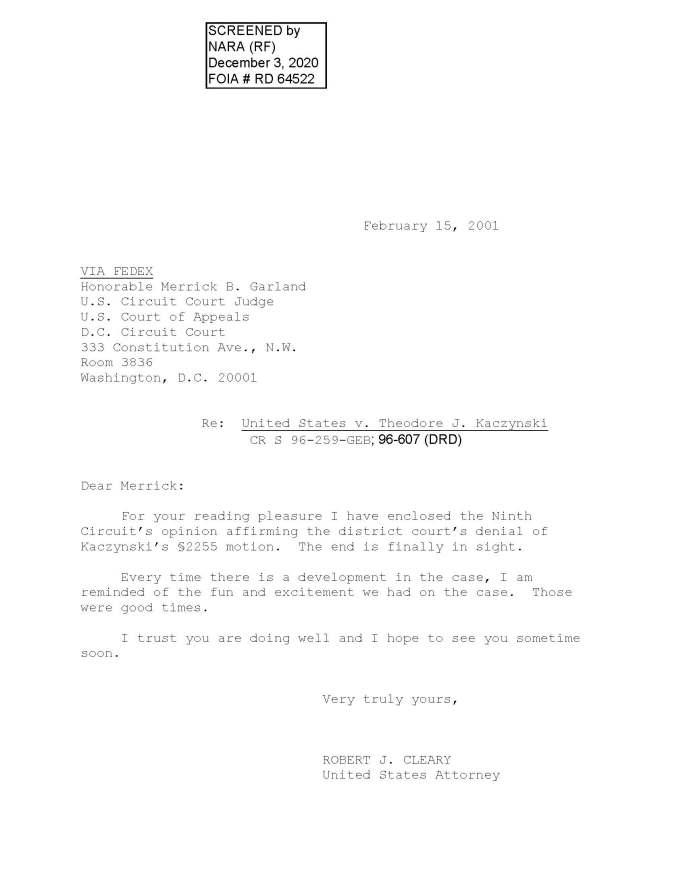
Letter from Robert J. Cleary to Merrick B. Garland regarding U.S. v. Theodore John Kaczynski Ruling; 2/15/2001 (NAID 236736945)
The appeal was decided on February 21, 2001, with the U.S. Court of Appeals, Ninth Circuit upholding the decision of the lower court and rejecting Kaczynski’s bid for a new trial.
